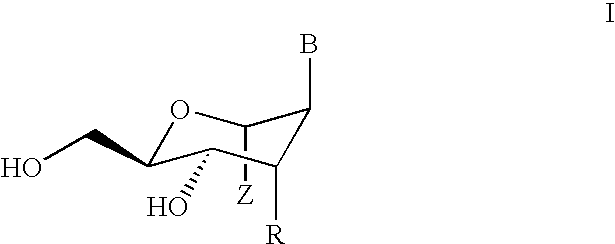Alkylated hexitol nucleoside analogues and oligomers thereof
a technology of alkylated hexitol and nucleosides, which is applied in the field of alkylated hexitol nucleoside analogues and oligomers thereof, can solve the problems of nuclease degradation and the long synthesis of altritol nucleic acid monomers
- Summary
- Abstract
- Description
- Claims
- Application Information
AI Technical Summary
Benefits of technology
Problems solved by technology
Method used
Image
Examples
example 1
3'-O-methylation
[0040] 1,5-anhydro-4,6-O-benzylidene-3-O-methyl-2-(uracil-1-yl)-2-deoxy-D--altro-hexitol (8.1).
[0041] 1,5-anhydro-4,6-O-benzylidene-2-(uracil-1-yl)-2-deoxy-D-altro-hexit-ol (7.1) (see reference [14]; 1.59 g, 4.6 mmol) was coevaporated with anhydrous acetonitrile (3.times.10 mL) and dissolved in anhydrous THF (40 mL). NaH (552 mg, 13.8 mmol) was added, and the reaction was left to stir for 30 min at 0.degree. C., whereupon CH.sub.3I (1.35 mL, 23 mmol) was added. After 5 hours stirring at 0.degree. C. an additional amount of CH.sub.3I (1 mL, 17 mmol) was added, and the reaction was left to stir another 2 hours at 0.degree. C. The reaction was quenched with water (20 mL), diluted with EtOAc (200 mL) and washed with NaHCO.sub.3 (2.times.50 mL). The combined aqueous phase was extracted with dichloromethane (50 mL), whereupon the combined organic phase was dried (Na.sub.2SO.sub.4), filtered and evaporated to dryness. Purification by silica column chromatography (0-2% MeOH / ...
example 2
Benzylidene Cleavage
[0043] 1,5-anhydro-3-O-methyl-2-(uracil-1-yl)-2-deoxy-altro-hexitol (1.1).
[0044] 1,5-anhydro-4,6-O-benzylidene-3-O-methyl-2-uracil-1-yl)-2-deoxy-D-a-ltro-hexitol (8.1) (390 mg, 1.08 mmol) was dissolved in 90% aq. trifluoroacetic acid (6 mL) and stirred at room temperature for 1 hour. Upon completion, the mixture was evaporated to dryness and coevaporated with toluene (2.times.10 mL). Purification by silica column chromatography (5-10% MeOH in dichloromethane) afforded the deprotected nucleoside 1.1 as a white foam (210 mg, 0.77 mmol, 71%). R.sub.f: 0.28 (10% MeOH / dichloromethane).
[0045] .delta. .sup.1H-NMR (DMSO-d6): 11.32 (s, 1H, NH), 7.98 (d, J=8.06 Hz, 1H, 6-H), 5.57 (dd, J=2.2, 8.06 Hz, 1H, 5-H), 4.85 (d, J=6.23 Hz, 1H, 4'-OH), 4.60 (t, J=5.86 Hz, 1H, 6'-OH), 4.46 (AB, J=3.66, 1H, 2'-H), 3.86 (d, J=3.66 Hz, 2H, 1'-H), 3.51-3.68 (m, 5H, 3'-H, 4'-H, 5'-H, 6'-H), 3.39 (s, 3H, OCH.sub.3). .delta. .sup.13C-NMR (DMSO-d6): 163.42 (C-4), 151.31 (C-2), 143.27 (C-6), 1...
example 3
6'-O-protection
[0046] 1,5-anhydro-3-O-methyl-6-O-monomethoxytrityl-2-(uracil-1-yl)-2-deox-y-D-altro-hexitol (9.1).
[0047] 1,5-anhydro-3-O-methyl-2-(uracil-1-yl)-2-deoxy-D-altro-hexitol (1.1) (460 mg, 1.69 mmol) was coevaporated with anhydrous pyridine (2.times.5 mL) and redissolved in anhydrous pyridine (10 mL). Monomethoxytrityl chloride (532 mg, 1.73 mg) was added, and the reaction was left to stir for 20 hours. After completion, the reaction was quenched with methanol (2 mL) and evaporated to dryness. The last residues of pyridine were removed by coevaporation with toluene. Purification by silica column chromatography (1-5% MeOH / dichloromethane) afforded the tritylated compound as a white foam (816 mg, 1.50 mmol, 89%). R.sub.f: 0.79 (5% MeOH / dichloromethane). The reaction alternatively can be carried out using dimethoxytrityl chloride.
[0048] .delta. .sup.1H-NMR (DMSO-d.sub.6): 11.40 (s, 1H, NEW, 8.06 (d, 3=8.1 Hz, 6-H), 6.88-7.43 (m, 14H, MMTr), 5.58 (d, J=8.1 Hz, 1H, 5-H), 4.80 (...
PUM
| Property | Measurement | Unit |
|---|---|---|
| Tm | aaaaa | aaaaa |
| Tm | aaaaa | aaaaa |
| temperature | aaaaa | aaaaa |
Abstract
Description
Claims
Application Information
 Login to View More
Login to View More - R&D
- Intellectual Property
- Life Sciences
- Materials
- Tech Scout
- Unparalleled Data Quality
- Higher Quality Content
- 60% Fewer Hallucinations
Browse by: Latest US Patents, China's latest patents, Technical Efficacy Thesaurus, Application Domain, Technology Topic, Popular Technical Reports.
© 2025 PatSnap. All rights reserved.Legal|Privacy policy|Modern Slavery Act Transparency Statement|Sitemap|About US| Contact US: help@patsnap.com



